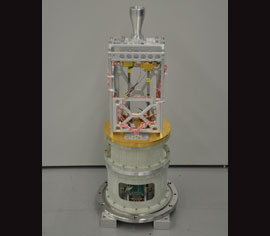ALMA Will Detect More Distant Objects with Band 1
Thursday, June 23, 2016
 Cartucho frío de Banda 1 de ALMA. |
 Leonardo Bronfman, astronomer at U. of Chile |
 Ricardo Finger, astronomer U. of Chile |
Development of receivers for ALMA Band 1 (31-45GHz) has begun after the Atacama Large Millimeter/sub-millimeter Array (ALMA) Board officially approved the production of Band 1 receivers. The Universidad de Chile, within an international team to develop Band 1 receivers, has been running a program for the construction of a prototype for band 1 of ALMA and is now mainly responsible for producing the optical system.
Academia Sinica Institute of Astronomy and Astrophysics in Taiwan (ASIAA) took a leadership role in the project in 2008. It was joined by an international team made up of the University of Chile, the NRAO, National Astronomical Observatory of Japan (NAOJ), the Herzberg Institute of Astrophysics (HIA), and the National Chung-Shan Institute of Science and Technology (NCSIST).
The ASIAA developed Band1 receiver is remarkable in its low noise, high sensitivity and high dynamic range of signal-receiving. "Technical requirements for ALMA Band1 receivers, due to the physical properties of this particular frequency band, are far more stringent than any other existing receiver systems”, said Ted Huang, Band 1 Project Manager at ASIAA, Taiwan.
With the Band 1 receivers installed in ALMA, the observatory will be able to detect the most distant and earliest star-forming gas reservoirs in the Universe, and to see dust grains grow to cm-sized pebbles around nearby stars: the first steps of planet formation.
“The fact that the ALMA Board approved Band 1 confirms the excellent technical level of all the members of the partnership,” says Ricardo Finger, part of the Band 1 team at the University of Chile, which will be responsible for two components of the optics of the receiver: the horn antenna and a Fresnel lens.
For ALMA’s Observatory Scientist, John Carpenter, the main drivers for Band1 development are “probing the evolution of dust grains as planets form in circumstellar disks; and detecting molecular gas in re-ionization epoch galaxies”.
The Band 1 covers a range of wavelengths from 6 to 8.5 millimeters (frequencies from 35 to 52 GHz). To date there are seven receivers that have already been developed and installed in each of the ALMA antennas. A total of 73 Band 1 receivers are to be manufactured and will be delivered by the end of 2019 and integrated during the first quarter of 2020. Band 5 cartridges are being constructed and delivered until 2017 and are being integrated to the antennas as they arrive. Band 2 is going to be completed in the future.
ALMA observes the Universe in radio waves: light that is invisible to the human eye. The weak electromagnetic glow from space is captured by the array of 66 antennas situated in the north of Chile. Their receivers transform this weak radiation into an electrical signal.




